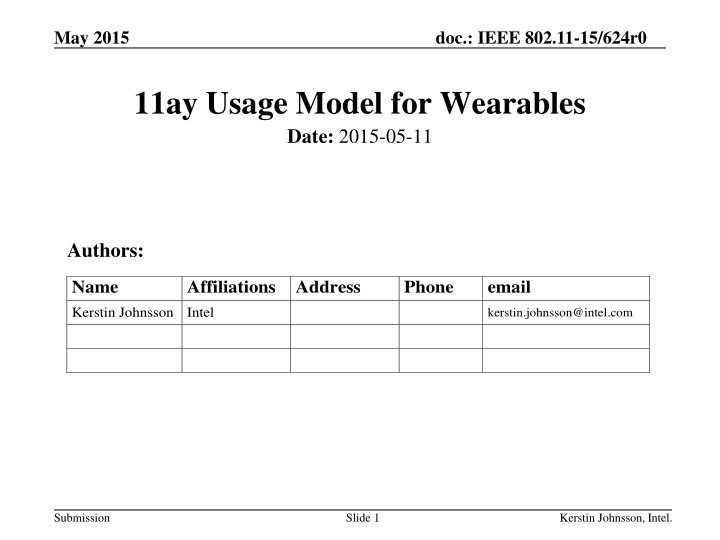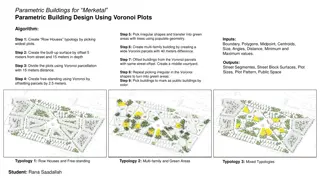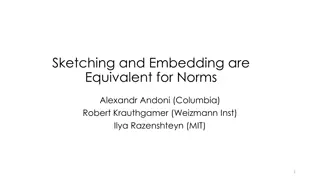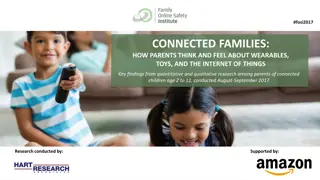Usage Model for High-End Wearables in Public Spaces
This document introduces a usage model for high-end wearables in public spaces, focusing on IEEE 802.11-15/624r0. It discusses the requirements and differences from existing use cases, emphasizing the increasing market for wearables and the challenges posed by dense device environments. The model considers scenarios involving heterogeneous wearables in commuter settings and applications with high data rates, low latency, and specific traffic conditions.
Download Presentation

Please find below an Image/Link to download the presentation.
The content on the website is provided AS IS for your information and personal use only. It may not be sold, licensed, or shared on other websites without obtaining consent from the author.If you encounter any issues during the download, it is possible that the publisher has removed the file from their server.
You are allowed to download the files provided on this website for personal or commercial use, subject to the condition that they are used lawfully. All files are the property of their respective owners.
The content on the website is provided AS IS for your information and personal use only. It may not be sold, licensed, or shared on other websites without obtaining consent from the author.
E N D
Presentation Transcript
May 2015 doc.: IEEE 802.11-15/624r0 11ay Usage Model for Wearables Date: 2015-05-11 Authors: Name Affiliations Address Phone email Kerstin Johnsson Intel kerstin.johnsson@intel.com Submission Slide 1 Kerstin Johnsson, Intel.
May 2015 doc.: IEEE 802.11-15/624r0 Abstract This document introduces a usage model: High-end Wearables in Public Spaces for 11ay. It provides details/requirements of this usage model and discusses how it differs from existing use cases in 11ay. Submission Slide 2 Rob Sun, Huawei
May 2015 doc.: IEEE 802.11-15/624r0 Why High-end Wearables in Public Spaces Usage Model? Wearables market is rapidly expanding and composed of a variety of form factors, functions, and QoS requirements. People are consistently more mobile and producing/consuming more content while in public Currently most of that involves smartphones and tablets. We believe the future includes more wearables, including glasses that eliminate the need for devices with large (or any) screens. Dense device environments place the greatest stress on our wireless solutions . Submission Slide 3 Kerstin Johnsson, Intel
May 2015 Heterogeneous Wearables in Public Spaces Part 1 of description doc.: IEEE 802.11-15/624r0 Environment Commuter scenarios (trains, buses, planes) 150-300 users per commuter car 20-40% of users have high-end wearable (e.g. augmented/virtual reality glasses, high def glasses, etc.) managed by smartphone/tablet Pre-conditions Smartphones and wearables all equipped with 11ay interfaces User s smartphone has formed a PBSS with high-end wearable All desired media content, processing power, and control procedures needed by wearables reside on smartphone Submission Slide 4 Kerstin Johnsson, Intel
May 2015 Heterogeneous Wearables in Public Spaces Part 2 of description doc.: IEEE 802.11-15/624r0 Applications High-end wearable (e.g. sends data to smartphone for processing; smartphone sends media content, processed data, and control to high-end wearable. Data rate > 10 Gbps Latency < 5 ms Jitter < 5 ms Traffic Conditions Device-to-device [D2D] links between the wearable and its smartphone are semi- stationary; interfering D2D links may be fast changing Desired D2D link distances range from a few cm to a meter D2D links (both target and interfering) can be LOS or NLOS Submission Slide 5 Kerstin Johnsson, Intel
May 2015 doc.: IEEE 802.11-15/624r0 Comparison with Existing Use Cases This use case is most similar to Huawei s Augmented Reality and Virtual Reality use case and Panasonic s USR Peer-to-Peer Device Sync use case. Use Case Characteristic Huawei s use case Panasonic s use case Low mobility devices Yes No (stationary) Data transfers at > 10 Gpbs, latency < 5msec, jitter <5 msec Yes No (non RT) Large numbers of interferers No (In home) Yes Link not necessarily LOS No (LOS) No (LOS) Link distance varies from 10cm to 1m No (10 ft) No (< 10cm) Submission Slide 6 Kerstin Johnsson, Intel
May 2015 Usage Model 3: High-End Wearables Augmented Reality and Virtual Reality Pre-Conditions: High-end wearable (e.g. augmented/virtual reality glasses) and its managing device (e.g. gaming console, smartphone, etc.) AR/VR wearable devices are equipped with NG60 11ay interfaces to stream video into the goggles. A user s high-end wearable and his managing device form a PBSS. All desired media content, processing power, and control needed by wearable reside on the managing device (i.e. internet connectivity not required). doc.: IEEE 802.11-15/624r0 Transmissions (both desired signal and interference) can be LOS or NLOS are mostly LOS. Desired device-to- device link is < 10 ft. Distance between far corners of the room are <10 m. Traffic Conditions: Potential interference from environmental factors and obstruction of the LOS. and interference from other 11ay users (e.g. other wearables, access points, etc.) Application: User plays high close-reality game using his high-end wearable (e.g. AR glasses) and managing device (e.g. gaming console, smartphone, etc.). more body movements, the gaming console streaming the videos All devices needs to must be able to tolerate the low mobility of the gamers moderate user movements. The dDevices might may be stationary or moving (pedestrian speed) while in use. might be used with low- mobility during usage. Use Case: 1. A passenger on a crowded commuter train is playing a game using his AR glasses and smartphone. Some percentage of his fellow passengers are also using their high-end wearables and smartphones for gaming, high- def media, etc. causing interference. Gamer is wearing his goggle to start the COD games on a platform. 2. All passengers are semi-stationary, i.e. they shift and move from time to time.is constantly moving left and right and crouching from time to time to simulate the battle scenes. 3. All passengers receive satisfactory QoE/QoS on their high-end wearables. Video is non-disruptively streamed down to the goggle from the gaming console which is about 8 feet in front of him. Ddata transfers at ~20 Gbps, latency < 5 msec, jitter <5 msec, PER<10E-2. Environment: Devices are operateing in home or in public. At home < 4 interferers. In public (e.g. commuter train) up to 120 potential interferers. Interferers have varying QoS requirements. room such as a living /media room. Submission
May 2015 Usage Model 3: High-end Wearables AR and VR doc.: IEEE 802.11-15/624r0 High-end wearables are used in home and public AR/VR is touting close-to-reality user experience with 3D video and 7.1 audio The wearable device is subject to low level mobility movement (neck roll, pitch, yaw, etc.) The video quality can support up to 3D 4K The operating environment is usually indoor <= 10 ft m Current products include Sony HMZ-T3 and VR glasses by Oculus Smartphones, tablets, gaming consoles, etc. can provide data processing, storage, content, and control to wearables Applications Sony HMZ-T3 VR goggles by Oculus Features Requirements Notes Distance 10ft Sony HMZ T1 supports up to 7ft Wireless HD Video Quality 3D 4K [1] HDMI 2.0 Range of Motion for head-worn wearable Neck Roll [2] 0.17 (s/60deg) Neck Pitch[2] 0.14(s/60deg) Neck Yaw[2] 0.13 (s/60deg) Range of motion for wearables and handhelds Pedestrian speeds Submission























